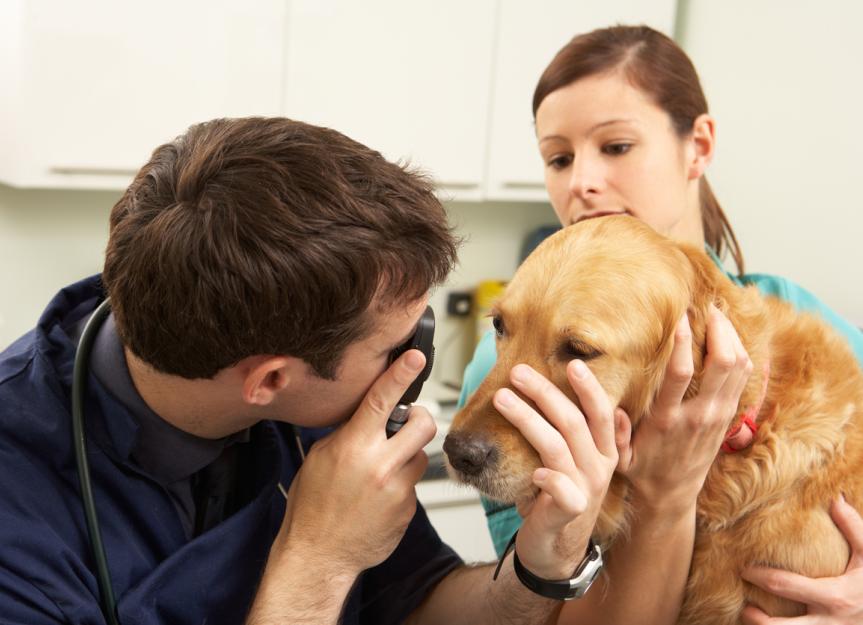Non-Ulcerative Keratitis (Corneal Inflammation) in Dogs
What Is Non -Ulcerative Keratitis (Corneal Inflammation) in Dogs?
Keratitis is a term used to describe inflammation of the cornea, the clear outer layer of the eye. Non- ulcerative keratitis describes an inflammatory process in the cornea.
A dog’s eye is made up of several tissue layers and anatomical structures. A dog’s eyelid is similar to those of humans, except for the nictitating membrane, or third eyelid. Just below the eyelid is the eyeball, or globe, which houses many structures necessary for vision.
Large structures that can be seen without specialized equipment include the cornea, the surrounding white tissue (sclera), the colored portion (iris), and the dark pupil in the center of the eye. With non-ulcerative keratitis, the cornea is the portion of the eye affected.
Acute non-ulcerative keratitis may not involve any obvious changes to the cornea at first, but in some cases it may be possible to notice a subtle cloudiness or haziness to the eye. When the condition becomes more chronic, buildup of dark pigmentation on the cornea begins. In contrast, ulcerative keratitis involves a disruption in the top layer of the cornea, which may or may not be visible with the naked eye and is diagnosed by your veterinarian.
There are several types of non-ulcerative keratitis in dogs, including:
- Infectious keratitis
- Caused by secondary bacterial, fungal, or viral infections
- Chronic superficial keratitis (pannus)
- Seen most commonly in German Shepherds
- Characterized by brown pigmentation on the cornea
- Pigmentary keratitis
- Most common in brachycephalic breeds
- Secondary to exposure to irritants in the air
- Also called exposure keratopathy
- Keratoconjunctivitis sicca (KCS)
- Most common in brachycephalic breeds, such as Cocker Spaniels andWest Highland Terriers
- May have an auto-immune component
These conditions may require different treatments, and which is why diagnosis and testing is so important.
Symptoms of Non-Ulcerative Keratitis (Corneal Inflammation) in Dogs
Visual symptoms of non-ulcerative keratitis include:
- Color change, white cloudiness or haze to brown discoloration
- Vascularization, appearance of blood vessels in the cornea
- Discharge from the eye, white, green, yellow, or clear
- Squinting
- Redness in the sclera surrounding the eye
- Inflammation of surrounding soft tissue areas
Nonspecific symptoms of non-ulcerative keratitis include:
- Lethargy
- Decreased appetite
- Impaired vision
Causes of Non-Ulcerative Keratitis (Corneal Inflammation) in Dogs
There are several possible causes of non-ulcerative keratitis in dogs, and determining the correct one affects prognosis and treatment goals. The most common causes of non-ulcerative keratitis include:
- Dry eye (decreased tear production) secondary to
- Sleeping with the eyes open
- Auto-immune disease, such askeratoconjunctivitis sicca
- Trauma
- Chemical irritants
- Exposure to air pollutants and materials (such as dirt, dust, and particles)
- Trichiasis (eyelashes rubbing the cornea)
- Infections (bacterial, viral, fungal)
- Breed predispositions
- Brachycephalic breeds,German Shepherds, Cocker Spaniels
- Secondary to other ocular diseases
- Glaucoma
- Neoplasia
- Anterior uveitis
How Vets Diagnose Non-Ulcerative Keratitis (Corneal Inflammation) in Dogs
Diagnosis of non-ulcerative keratitis typically starts with a basic physical exam as well as blood work, urinalysis, and possibly x-rays to make sure there are no underlying reasons for the inflammation outside of the eye. Testing specific to the eyes includes:
- Fluorescein stain:A small amount of green fluorescein dye is dropped into both eyes and then rinsed with eye wash. A black light is then used to illuminate areas of stain uptake in the eye. If a portion of the eye glows green, that indicates an ulcer.
- Schirmer tear test:To diagnose dry eye, two small strips of tear testing paper are placed between the eyelid and the cornea and left for a short period of time. Tear film travels up the paper and allows the veterinarian to assess if the amount of tears is appropriate.
- Ocular culture:A small swab of fluid surrounding the cornea is submitted to the laboratory to grow and analyze any bacteria that may be present.
Treatment of Non-Ulcerative Keratitis (Corneal Inflammation) in Dogs
Treatment of non-ulcerative keratitis depends on the underlying cause of the inflammation. Common therapies include:
- Antibiotics
- Steroids
- Lubricants
- 免疫抑制读出cations
- Antibiotics for bacterial infection, specific to the bacteria found
- Steroids, also known as anti-inflammatories, for pain and inflammation (but not if an ulcer is present)
- 免疫抑制读出cations, such as cyclosporine, if dry eye is a component of the dog’s keratitis
While there are a lot of home remedies available for eye infections in dogs, it is important to consult with your veterinarian prior to usage. Many homeopathic medications are not FDA-approved and using them may delay healing and worsen clinical signs.
Recovery and Management of Non-Ulcerative Keratitis (Corneal Inflammation) in Dogs
The timeline of recovery depends on the underlying cause of the inflammation. Many dogs with non-ulcerative keratitis require lifelong therapies if the condition is related to an auto-immune disease or chronic superficial inflammation (pannus). In cases of trauma, infection, and confirmational causes like trichiasis, full recovery is possible once the underlying cause is addressed and treated.
它不可能完全防止non-ulcerative keratitis, as some dogs are predisposed to this condition. For example, brachycephalic breeds are more at risk for trauma and secondary infections. Cocker Spaniels are at high risk for the development of dry eye, and German Shepherds are known to develop pannus. Although complete prevention may not be possible, talking with your veterinarian as soon as you notice any abnormalities is the first step in preventing progression of the disease.
Non-Ulcerative Keratitis (Corneal Inflammation) in Dogs FAQs
How do you treat an inflamed cornea in dogs?
If no ulceration is present, your vet may recommend anti-inflammatories, such as topical steroids, along with antibiotics and lubrication as needed.
What causes inflammation in a dog’s eyes?
Inflammation is secondary to irritation, infection, or immune stimulation.
Can I give my dog human eye drops?
While there is some crossover between human and dog eye medications, some are dangerous to use, depending on the underlying disease. Talk to your veterinarian prior to starting any topical or oral medications.
How can I treat my dog’s eye infection at home?
At this time, at-home treatment without consultation with a veterinarian is not recommended. Inappropriate treatments may put your dog at risk for worsening of disease and permanent vision loss.

